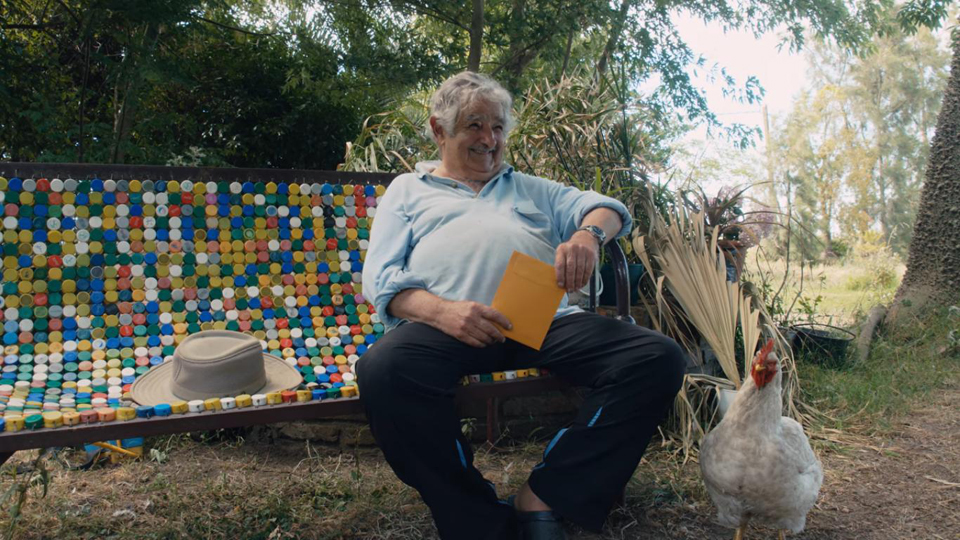
At first glance, he’s a gnarled, wizened, disheveled, weather-beaten old man. He could use a trim and new clothes. He sits on a bench at his farm, the chickens pecking for insects in the ground around his feet.
He’s talking slowly, but thoughtfully, to Serbian filmmaker Emir Kusturica, two-time Cannes Palme d’Or Prize Winner. “One has to try to live as the majority does, not like the minority does,” he explains. José “Pepe” Mujica lives like the majority. He is the President of Uruguay, being interviewed for a 73-minute Netflix biopic on his life. He is honest and direct. His five-year term ends in a few days (March 1, 2015).
El Pepe plows his own fields, lives in a less than modest house, drives his old blue VW bug unhurriedly but steadily through the fields and working-class neighborhoods to visit his fellow citizens.
He stops the car to tour the housing he has worked so hard to build for the poor. “The market never gets housing to the poor,” he observes. So he takes pride in these 1500 units. A mother of ten kids tells him how much difference this housing makes. “Thank you, El Pepe. We stand with you. We love you.”
“Nine years ago when we came to power, we had a poverty rate of 39%. Now,” notes El Pepe, “it is 11%.” Education is more accessible. Material and economic improvements have pushed up living standards. (Before his election to the presidency, Mujica was Minister of Livestock, Agriculture and Fisheries from 2005 to 2008.)
But José Mujica is not a hero to everyone. As young people, he and his wife Lucía Topolanksy saw banking and international capitalism establish a system which impoverished their country. Foreign companies took national resources and paid slave wages. A series of right-wing coups, funded often by the U.S., coordinated secret armies and set up and ran repressive regimes throughout South America. Fascist gangs attacked labor unions, students and political activists. Unionists were kidnapped. Jews were branded with swastikas.
Mujica and Topolansky organized resistance in a group called the Tupamaros. They funded the opposition by robbing banks and large international companies. “The biggest crime is the banking system,” avers El Pepe, in paraphrasing a well-known formulation of Bertolt Brecht. “It was no sin robbing a bank. Are you going to compare robbing a bank with creating a bank?”
The leadership group of Mujica, Eleuterio Fernández Huidobro and Mauricio Rosencuf were imprisoned, led a tunnel escape of 160 inmates from the notorious Punta Carretas Prison and recaptured. In all, he escaped four times and was recaptured. He was kept in squalid conditions in isolation for 13 years (1972-85), tortured, shot several times in the abdomen and legs, had his spleen removed, starved and repeatedly deprived of water. For two of those years, he was confined to the bottom of an old emptied-out horse-watering trough. He and his comrades laugh as he relates how they drank urine to survive when they were not allowed water. “We know all the prisons in this country!”
He also now knows the world leaders from the Pope to former President Obama. The struggle may seem more pragmatic than ideological now, but it still pushes forward.
José Alberto Mujica still tries to communicate a better future. “Capitalism is not the answer. We need to find something else, another way. We belong to that search. My wife and I have dedicated our lives to changing the world. We thought socialism would be easier to achieve. We are all socialist because we have to cooperate to form societies!”
As the familiar blue VW bug deliberately motors its way to the Capitol building for the last time, the streets all the way from the countryside to the city are lined with adoring crowds. “We love you, El Pepe,” they scream. Little children jump up and down. Men and women lean into his car’s open window to kiss their Pepe. The celebration in the capital of Montevideo is huge and joyous.
“Words divide us, actions unite us,” the grizzled old man tells the adoring throngs. “I’m not leaving. I am arriving. Wherever I am, I will be there for you.”
That’s what a hero looks like. The trailer can be viewed here.










